Latest AI buzz in the Valley & @SXSW

Dr. Stefan Ferber
1. Layman’s AI Perplexity resolved
For ten days I was flooded with AI buzzwords like Small Language Models (SLM), Agentic AI, Reinforcement Learning From Human Feedback (RHLF), or Artificial General Intelligence (AGI) during my delegation trip to Silicon Valley and the SXSW conference in Austin, TX. The hype is relentless, but here’s a thing: I’ve been in this game long before AI went mainstream.
I trained my first artificial neural network (ANN) back in 1993, dedicating my master’s thesis to the subject. At the time, I bet on well-engineered models over machine learning-driven ones. Why? Because training models was painfully slow, even on the fastest parallel computers, and gathering enough quality data to train them properly was nearly impossible.
Then everything changed. ChatGPT was the inflection point, a moment when AI stopped being a niche obsession and became a tool for the masses. Cloud computing unlocked near-unlimited processing power. The internet turned into an all-you-can-eat buffet of training data—often free for the taking. China, in particular, took a methodical approach, harvesting vast datasets from facial recognition, license plates, and online behavior.
Hence, I was still puzzled by the buzz of AI over the last 2 years. Now, after this trip I got why?
The valley decided that it is time to bring AI to the masses. This collective movement in the USA and China, to some extent in the EU, brings talent, money, and technology in amazing cadence to the market.
2. AI as a tech-social movement
The numbers are staggering. Since 1998, 10,000 AI startups have raked in a jaw-dropping $520 billion in funding—about $200 billion of that just in 2024 and 2025 alone, according to Crunchbase. And Silicon Valley? Still the undisputed king, pulling in half of the $90 billion in VC-backed AI deals last year.
The valley ecosystem has 40,000+ startups in AI, Life Science, Space & defence, and Climate-Tech & Energy not only engineering AI technology but also putting AI into the business practice across these domains “brutally”.
Richard Florida’s 3T framework—Talent, Technology, and Tolerance—is in full force in the Valley and interesting also in Austin, TX. The logic is simple: Open, inclusive communities attract top-tier talent and cutting-edge innovation. One example? AI researcher and entrepreneur Richard Socher. After selling his first AI startup, MetaMind, to Salesforce in 2016, he’s now reinventing AI based search with you.com. Could he have pulled this off at his alma mater, TU Dresden? Unlikely.
It’s not just startups in the race—tech giants are desperate to stay ahead. Intel’s stumble as NVIDIA surged is a cautionary tale, and no one wants to be the next industry relic. Or follow the shock moment at Google catching up with OpenAI the last 2 years. Big Tech is pumping billions and brains into AI, ensuring they don’t miss the boat.
Fueled by the geopolitical competition between the USA, China, and EU we are ending up with a lot of brains in an Olympic-like high performance mode. And in this race, there’s no silver nor bronze medal — only gold.
3. Expert’s Perplexity unresolved
This tech-social-economic movement delivers astonishing news in unforeseeable speed. Even AI experts fully dedicated to analyzing the market like Sam Jordan, Technology & Computing Lead at FTSG.com admit:
“That’s the nature of AI right now: What’s bleeding-edge today might be old news ... later today.” Future Today Strategy Group, 18TH EDITION 2025 TECH TRENDS REPORT page 44.
Proudly presented by Amy Webb’s SXSW keynote, which gives an excellent summary and if you want the details download their trend report to read yourself. She said:
“Expect a continued frenzy of activity as AI companies compete for market share, though investments and policies will concentrate influence among several key players.”
Here comes the summary of page 46, extracted and partially rewritten by “Gemini Advanced 2.0 Flash” , my newest work horse at SXSW ;-
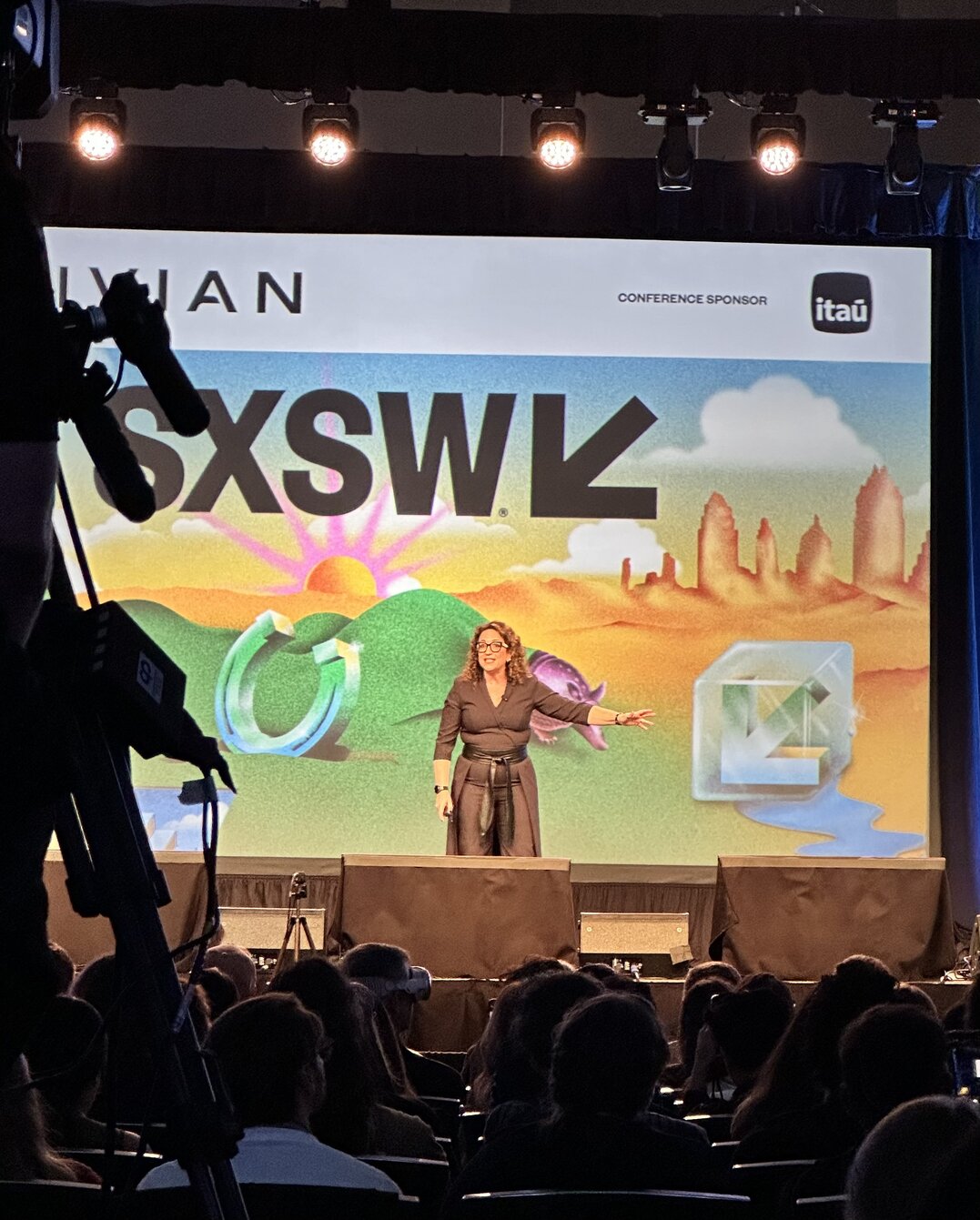
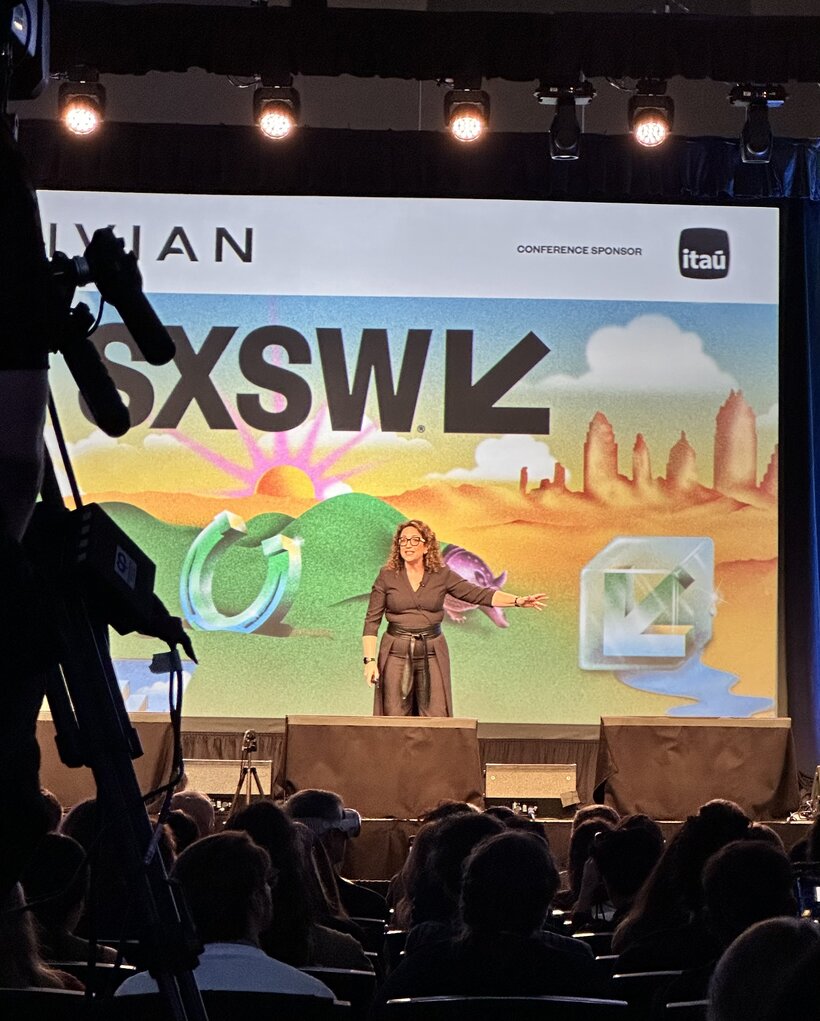
3.1. Harder, better, faster, stronger
Recent breakthroughs are challenging the prevailing notion that AI progress necessitates ever-larger models. DeepSeek's R1, along with S1 from Stanford and the University of Washington, have demonstrated strong reasoning capabilities while maintaining cost-efficiency. This raises important questions about the future of AI scalability and suggests that significant advancements can be achieved without simply increasing model size.
3.2. Your AI now has eyes and ears
AI systems are rapidly evolving beyond text processing. Advancements in multimodal AI, such as Google's Gemini Live and OpenAI's Sora, are enabling machines to process and generate text, audio, and video. This unlocks new possibilities for richer and more interactive AI experiences, fundamentally transforming how machines perceive and interact with the world.
3.3. AI Models Evolve into Thought Partners
AI performance is steadily improving, with models like OpenAI's O1 and Google's Gemini 2.0 Flash Thinking Mode moving beyond simple information retrieval. These advancements are elevating AI systems to the role of thought partners, capable of more sophisticated reasoning and problem-solving. Notably, in late 2024, OpenAI's O3 achieved an 85% score on the ARC-AGI benchmark, matching the average human score.
3.4. From assistance to autonomy
Agentic AI is transitioning from task assistance to autonomous reasoning and action. In 2025, AI agents are expected to not only assist with tasks but also execute complex processes independently. This evolution promises to transform industries through increased efficiency and automation.
3.5. US and China race ahead
The US and China are engaged in a high-stakes competition for AI dominance, with significant implications for the future of technology and global power. Both nations are investing heavily in AI research, infrastructure, and regulation, shaping the trajectory of innovation, security, and economic influence.
4. So what?
Yeah, yeah, the hype cycle. We get it. You're waiting for the Gartner curve to flatten, for AI to morph to “Plateau of Productivity” in a few years.But our experience at TREEO gives us massive productivity and creativity improvement already today, even though we don’t strategically embrace AI yet. If you don’t want to continue your AI journey you can stop reading here…
5. Weaving AI into your business & daily practices
Most AI sessions at SXSW were dedicated to embrace today’s AI technology in your company and show what we can expect in the near future. And at the very end of this post there is the list of sessions I can recommend. You can listen or for some even see the videos recorded.
SXSW wasn't just a tech bro echo chamber; it was rather a masterclass in AI adoption. Forget theoretical hand-waving; we're talking tangible, actionable strategies. How do you thread these neural networks into the very fabric of your business? How do you leverage machine learning to amplify your daily grind? And to help you decipher that digital dialect, I've compiled a my favorite list of SXSW AI sessions that cut through the noise. Dive in, plug in, and prepare to be assimilated. Or, just watch the videos.
5.1. The Future Distilled: MIT's 2025 Tech Forecast, Heavy on AI
Every year, the MIT Technology Review drops its "10 Breakthrough Technologies" list, a curated glimpse into the bleeding edge of innovation. It's not just about shiny gadgets; it's about tectonic shifts. And at SXSW, Niall Firth unveiled the 2025 Breakthrough Technologies, a vision saturated in artificial intelligence.
The MIT Technology Review publishes every year the list of 10 Breakthrough Technologies:
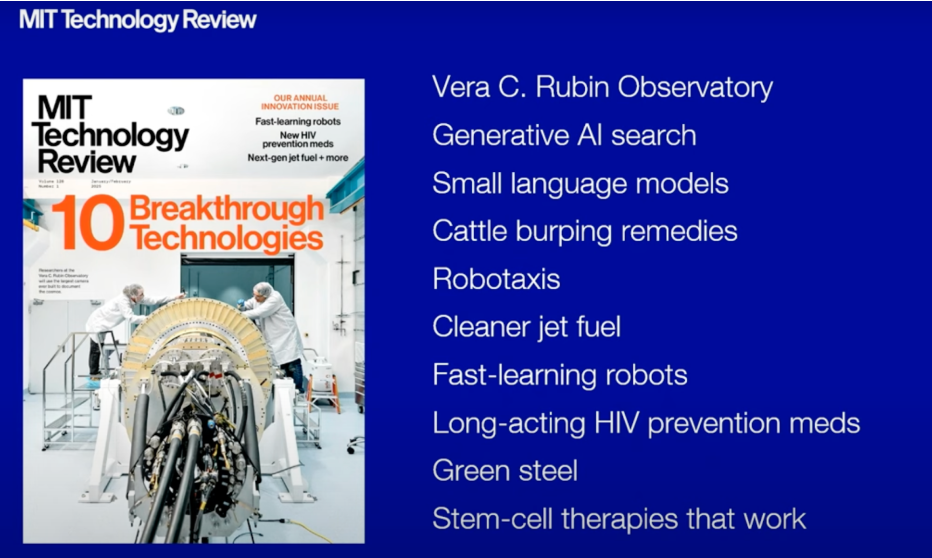
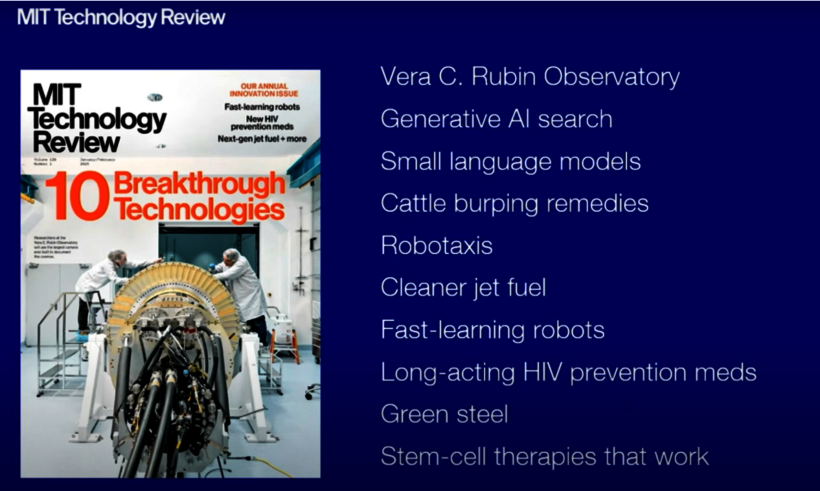
At SXSW Niall Firth presented the 2025 list which contains four AI related breakthroughs:
- Generative Al search, powered by Large Language Models, is turning the internet into a conversational partner. No more sifting through endless blue links; just ask, and the AI delivers. It's a seismic shift in how we interface with information, a move from search results to search dialogue.
- Small Language Models: Bigger isn't always better. Small Language Models are proving that focused training on niche datasets can yield hyper-relevant results, all while sipping resources. Think bespoke AI, tailored to your specific needs, without the server-farm footprint.
- Robotaxis:
Robotaxis are no longer a sci-fi fantasy. Waymo's clocking 200,000 trips a week, while Baidu's Apollo fleet has ferried 9 million passengers in China. China’s dominance is clear, with robo-taxis operating in 16 cities. The autonomous revolution is rolling, and it’s happening now. - Fast-learning robots: No more pre-programmed tasks as robots are adapting with the context, leveraging models to navigate uncharted territory.
MIT Tech Review's criteria are tough: long-term impact, commercial viability, and a clear-eyed assessment of both the upsides and the potential pitfalls. This isn't just a list of cool toys; it's a roadmap to the future, and AI is driving.
5.2 Five evolution steps to embrace “AI as a new species”
Neil Redding, self-styled "near futurist," isn't just preaching about AI; he's mapping its evolutionary trajectory for practical use . Forget the tired "tool" analogy. Redding's SXSW session laid out a five-stage mental model, a roadmap for our increasingly intimate relationship
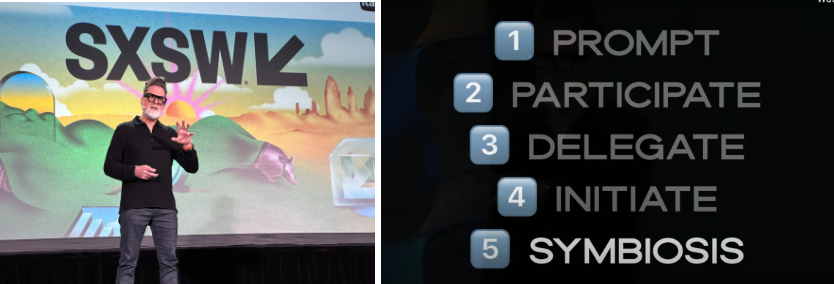
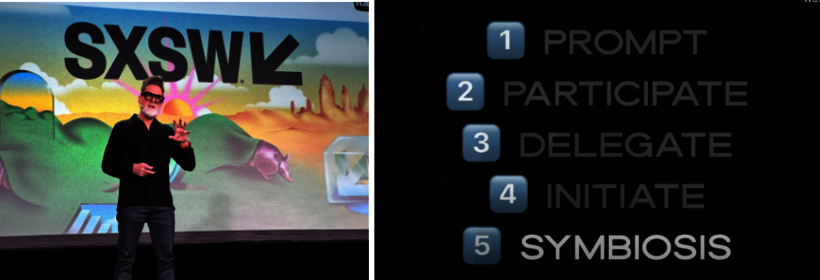
- Prompt. The Familiar Frontier. You know this drill: feed a Large Language Model a task, like distilling a sprawling document into a single, digestible page. It's the AI equivalent of a quick errand, efficient but transactional.
- Participate. The Algorithmic Confidante. This is where things get interesting. Imagine asking ChatGPT, "What impact do you think I should be making?" and receiving a genuinely insightful response. Then, imagine that same AI delivering personalized advice every morning. Suddenly, you're not just using a tool; you're collaborating with a digital mentor.
- Delegate. The famous Intern with Superpowers. Welcome to the era of the AI agent. Redding envisions tools like Claude autonomously executing tasks on your computer, from planning your next SXSW pilgrimage to booking flights and hotels. It's still nascent, a bit clunky, but the "agent hype" is real, and the potential is undeniable.
- Initiate. We're already seeing this in finance, where algorithms make split-second buy&sell decisions. Social media is full of this like @MIZUKI. But Redding sees it expanding, infiltrating every corner of business. There is "physical AI," NVIDIA's big bet, and it's poised to rewrite the rules of automation.
- The final stage is Symbiosis: AI seamlessly integrated into the business ecosystem, a true partner in the workplace. It's not just a tool; it's a teammate, a collaborator, a digital co-worker. This is where the line between human and machine blurs, and the future of work gets seriously weird—and potentially, seriously powerful.
5.3. Startup Speedrun in 50 Minutes
Join a new type of AI hackathon: Tom Hewitson just redefined rapid prototyping. In his SXSW session, "Practical Skills to Get Started in AI," the General Purpose AI education guru didn't just talk about AI; he unleashed it.
Tom used AI tools to generate a startup idea based on audience input - a voice-driven sleep journal and note-capturing device to sleep well after a stressful day. Hewitson, armed with an arsenal of AI tools ChatGPT, Perplexity, Replet, suno, runway, and midjourney went to work.
Market research? Check. User research? Done. Brand guide? Generated. The audience, a collective hive mind, christened the startup "Nocturne," its tagline: "Tranquility in digital form." Within minutes, Hewitson conjured a landing page and a demo video, using Replit and Runway. He even simulated app functionality. Fifty minutes. Fifty. It was a masterclass in AI's disruptive potential, a real-time demonstration of how these tools can compress months of startup development into a single, frenetic session.
But Hewitson wasn't just preaching technological evangelism. He grounded the spectacle in a sobering discussion of AI's ethical implications, emphasizing the crucial role of human creativity and the need for consumers to demand responsible AI development. This wasn't just about speed; it was about steering the AI revolution in a direction that benefits all of us.
5.4 The Rise of the AI-Native Enterprise
Matthew Duncan, the architect behind Microsoft's WorkLab and the sprawling Work Trend Index involving 31,000 people across 31 countries, isn't just tracking the future of work; he's dissecting its DNA. His SXSW session zeroed in on a new breed of organization: the AI-native company, point echoed in a recent Wall Street Journal article, entities built from the ground up with AI woven into their very core. Forget retrofitting AI into legacy structures. What makes them unique: “it is their mindset”:
- Everyone is an expert: Democrotize expertise across the organization
- Savor every byte: No data left on the table
- Flat + Fluid = Fast: Flatter and more fluid organization
- 1+1 = 3 billion: Compounding advantage
- Use AI on both as offense and defense in your business
Duncan illustrated these principles with case studies from companies like supernatural, CueZen, Cresta, StackBlitz,and ICG.
The session left me with a lingering question: if TREEO were born today, as an AI-native entity (already cloud-first, of course), how would its architecture, its culture, its very essence, be transformed? How would we do it?
5.5. How not to screw up AI?
Ian Beacraft form Signal and Cipher session on How Not to Screw up an AI Transformation While Shaping the Future of your Company emphasizes the paradigm shift we are going through while embracing AI:
“We’re attempting to navigate the 21st century digital landscape using the productivity metrics developed when steam engines were cutting-edge technology.”
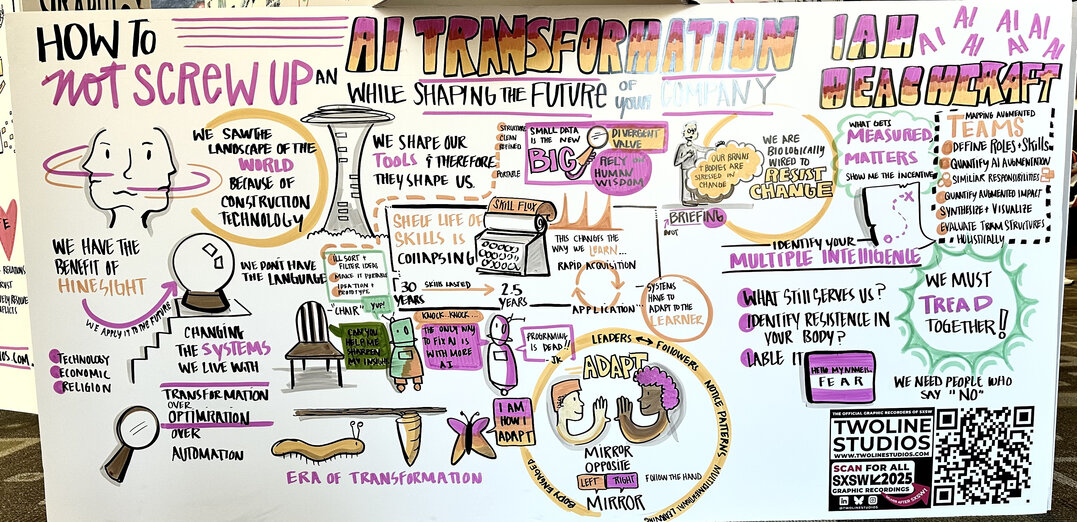
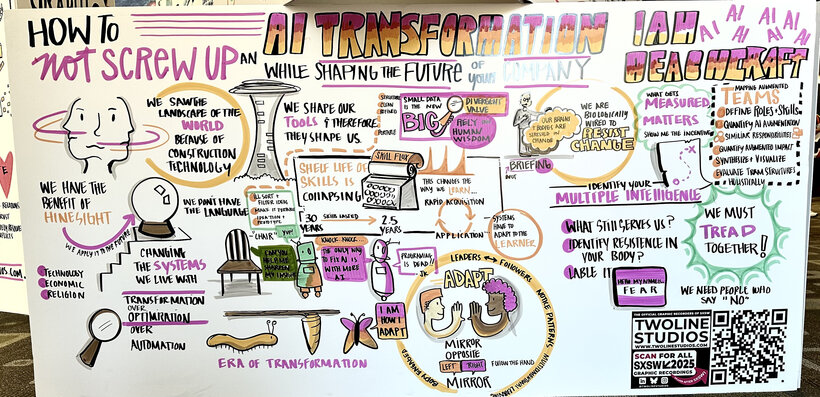
His five hypertheses are:
- Skills are the new data: shelf-life of skills is collapsing from 30 years in the past to 0.5-5 years in the future. And at the same time we are even getting older. Leading to a new paradigm of continuously speed learning called “Surge Skilling”.
- Understand your multiple intelligences: if we compete with the machines we’ve already lost.
- Small data is the new big: having our own organizations data accessible and usable with AI the amount of scaling efficiency will be insane. Large Language Models (LLMs) commodify the majority of accessible human knowledge over time and therefore will make you just average. Therefore, better we focus on divergent value by codifying your own organizational knowledge e.g. see list here.
- New KPI: Today Productivity is a religion, hence the AI era needs new metrics like breakthrough rate, learning velocity experimentation rate. The Lean AI startup leaderboard features organizations reaching revenue of $5-30 Mio per employee.
- Creative Generalist 2.0: Mapping augmented teams with people and AI
Wow, how to put all of this into practice?
5.6. Prepare for a relationship with your AI agent at work
Neil Redding, channeling his inner futurist, isn't mincing words: "AI is a new species." He echoes Peter Diamandis's stark warning: “There will be two kinds of companies at the end of this decade: Those that are fully utilizing AI, and those that are out of business.”
Looks like everyone on stage agrees on the “The Intern Test”: if you can clearly articulate a task to a hypothetical, intelligent intern, you can likely offload it to an AI via a well-crafted prompt.
But this algorithmic Darwinism raises a thorny question: how do we train the next generation when AI does the heavy lifting? If nascent professionals rely on AI from day one, do they risk atrophying fundamental skills? How does one build mastery without grappling with the messy, foundational problems that AI effortlessly solves? Are we breeding a generation of prompt engineers, or are we cultivating true craftsmanship
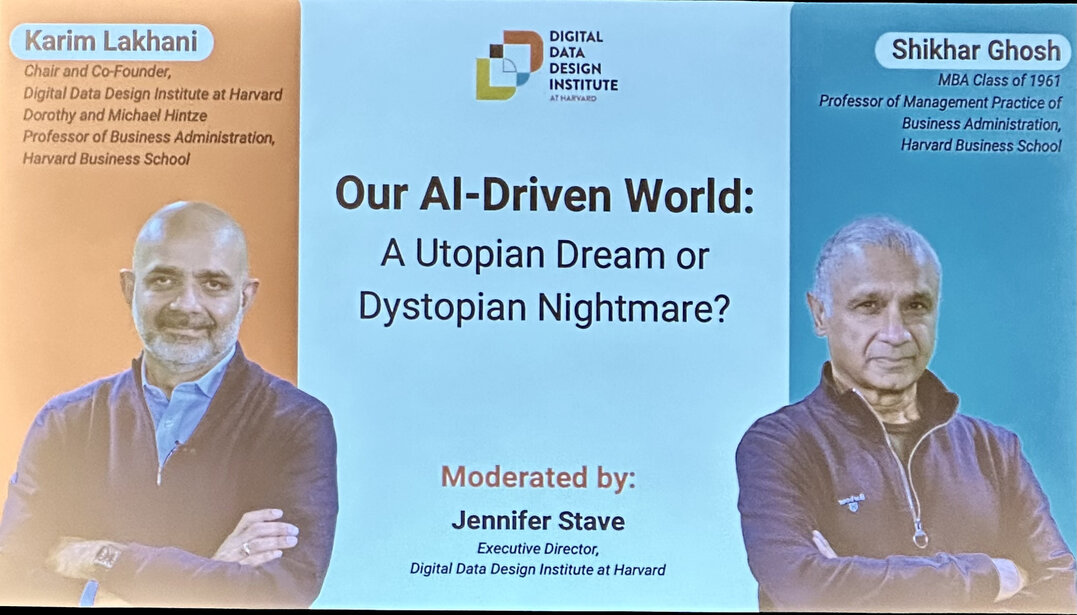
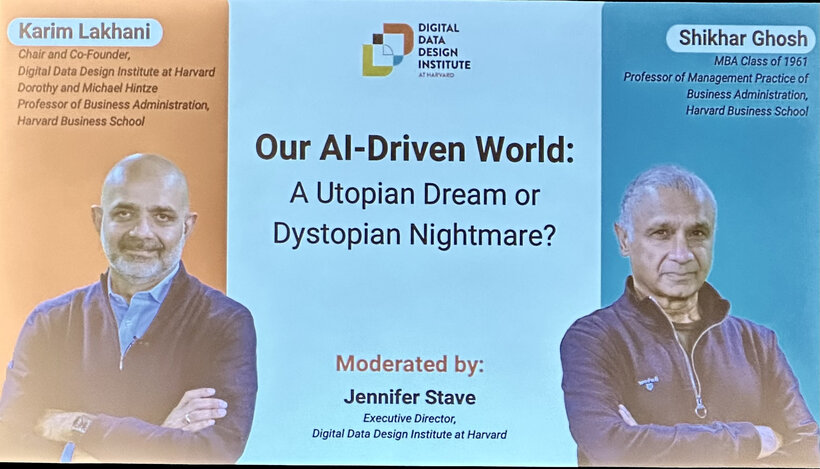
Harvard's Digital Data Design Institute, helmed by Karim Lakhani and Shikhar Ghosh, is diving headfirst into this brave new AI world. Their SXSW session “A Utopian Dream or Dystopian Nightmare? unveiled a radical hiring paradigm: applicants submit CVs detailing not just their human skills, but also the "bots they've been working with." Companies then assemble entire teams, human and AI, blurring the lines between employee and technology. And if the bots can handle the workload? "You don't have to show up," they suggest, a chillingly efficient vision of the future. Are we entering an era of radical automation, or are we witnessing the dawn of a new form of collaborative intelligence?
5.7. Emotional Machines: How AI Makes Us Feel
At SXSW, panelists explore AI’s ability to tap into human emotion—and maybe even something deeper. AI isn’t just crunching numbers or automating workflows anymore. It’s edging into the realm of feeling.
That’s the provocation Robyn Landau, director of Kinda Studios, put forward at the SXSW panel Emotional Machines: AI, Feeling & the Human Body opened with a mesmerizing video from Barney Steel’s experimental studio, Marshmallow Laser Feast. Known for pushing the boundaries of perception, the studio’s latest work uses AI to analyze trees—not just their form, but their breath, their subtle interactions with the world. The result? A sensory experience designed to deepen both awareness and meditation.
Steel shares his breath experience: "We've been doing a whole series on breath relationships, trees, and the more that you sort of follow that journey of breath, you realize that, on such a deep cellular level, we're woven into these relationships that aren't available to our eyeballs," and adds "For me, that's this kind of magical place where deeper understanding can come through spatial experiences, being able to understand connection to a tree through breath, senses, virtual reality." How does this sound to all the tree lovers out there?
Danielle Krettek Cobb, chief creative adviser at Hume AI, takes a different approach to the emotional potential of AI—through voice. She works with startups developing AI that can understand human cadence and inflection, pushing toward a future where digital interactions feel more intuitive, more empathetic.
And robots can dance, raising up the mood at Capital Factory House where startup crawl for the evening cocktail, music, and tech talk The Capital Factory is Austin's hot spot for startups and the go-to-place during SXSW
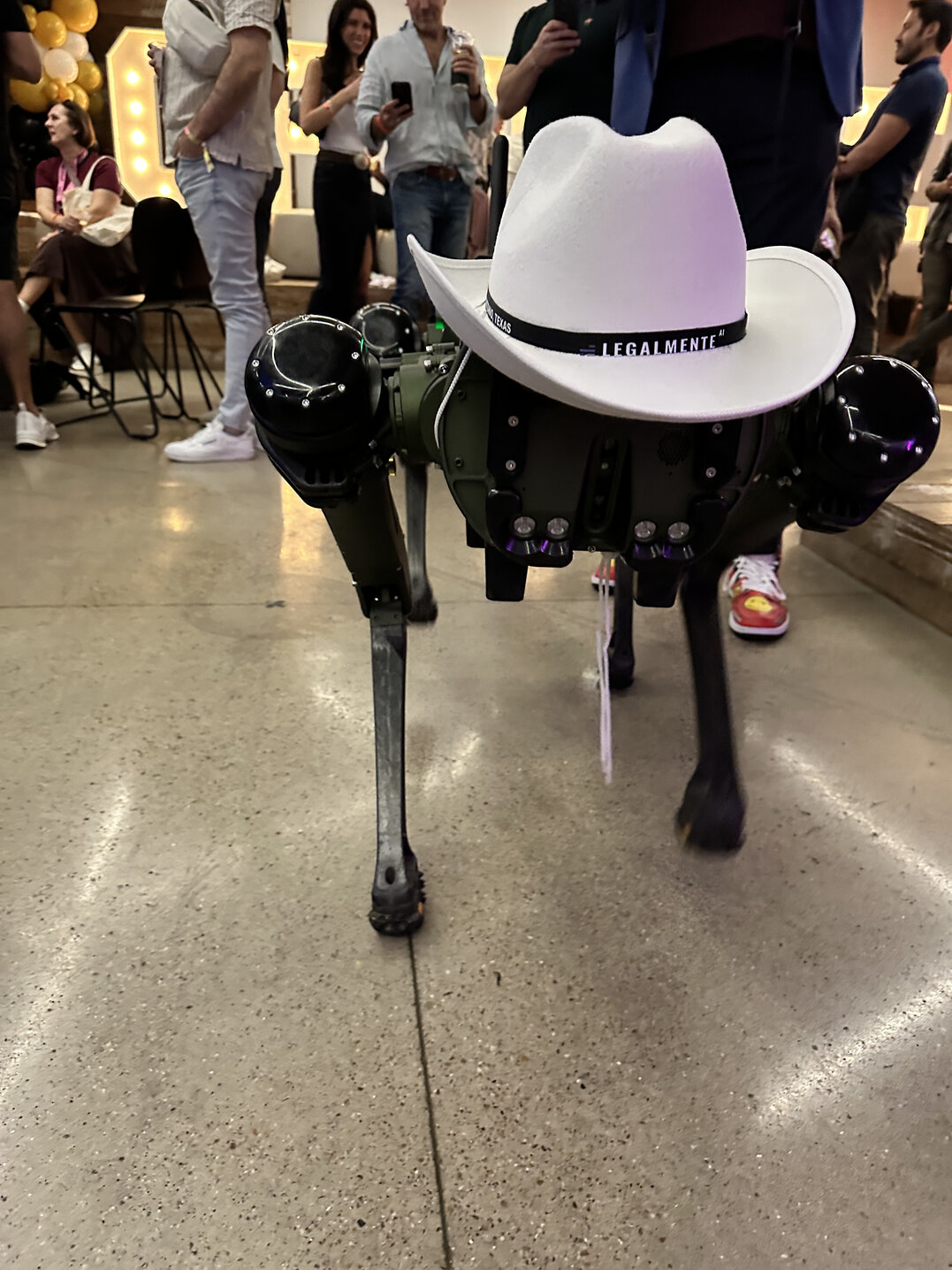
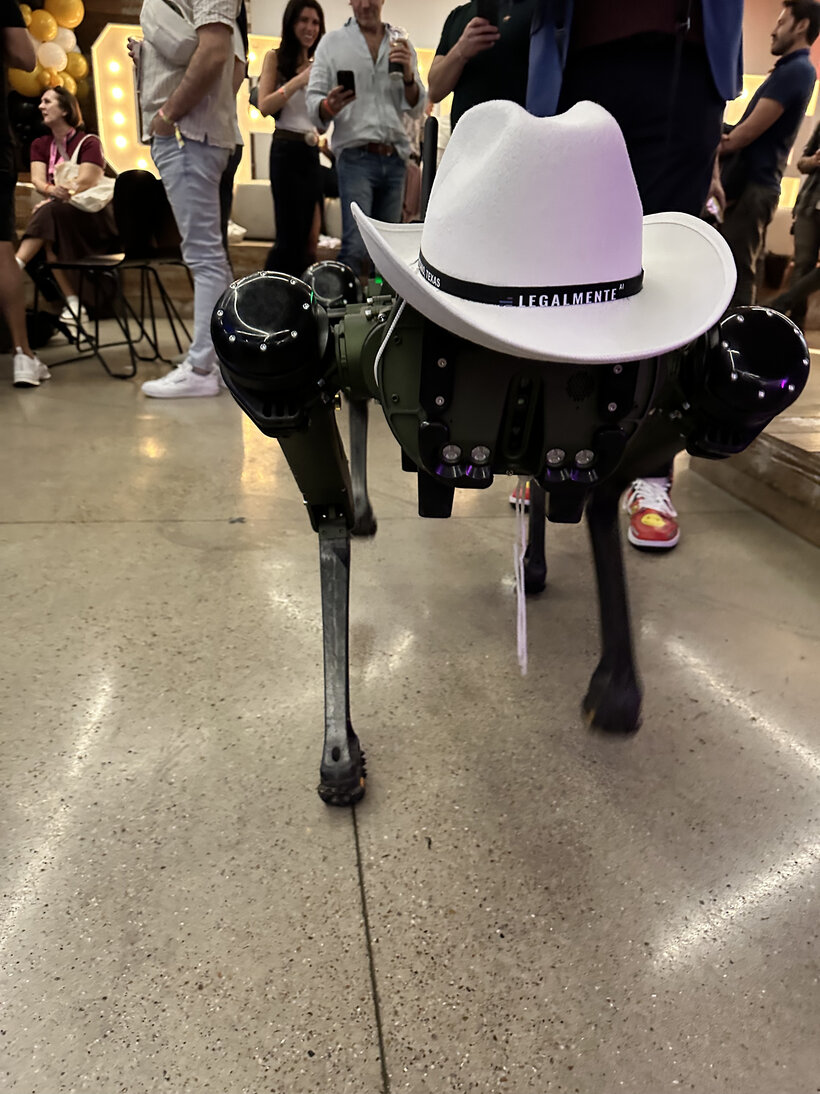
6. Big tech AI perspectives
Arvind Krishna, IBM's CEO, had a calm session at SXSW. IBM's recent business success, he argued, hinges on two pillars: a pragmatic hybrid cloud strategy—a tacit acknowledgment that "not ONE cloud to rule them all" and a laser focus on deploying AI for real-world business problems.
But Krishna wasn't content to dwell on the present. He doubled down on IBM's commitment to quantum computing, a paradigm shift that promises to rewrite the rules of computation. IBM's announcement that they're joining the Quantum Computing Hub in South Chicago signaled a renewed push into this frontier. Illinois Governor JB Pritzker joined on stage to explore how the state quantum industry works strategically.
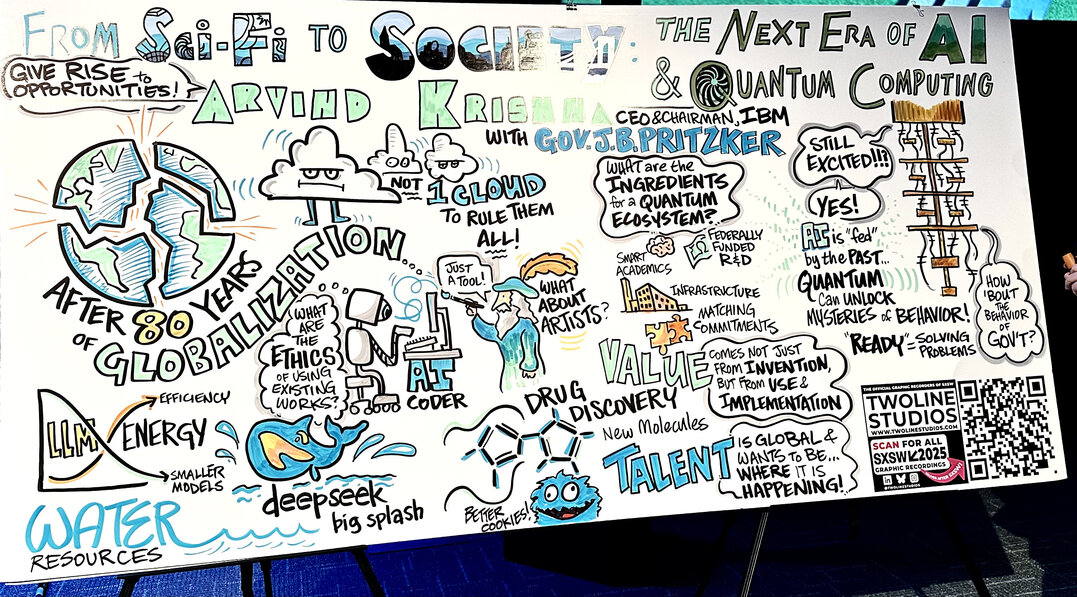

Rene Haas, ARM's CEO, wasn't offering vague pronouncements at SXSW. He delivered a sharp, focused AI strategy: ARM is betting big on the edge. In addition to centralized cloud processing Haas envisions a future where AI hums on your phone, in your gateway, within your IoT gadgets. The challenge? Power & heat. ARM's strong legacy, powering 300 billion devices, is built on efficiency. Now, they're extending that expertise to AI, crafting chips optimized for on-device intelligence.
Rene also shared his view that LLM will have two very different business models and data sets for
- end-consumers and
- enterprises.
And he is cautious for any specific AI prediction
“… because a smartphone is a device that we can’t live without. And for almost 2000 years we obviously lived without it”
The movie industry has been a strong technology innovator over decades. Just remember “Bullet-Time” of the Matrix. That’s why Phil Wiser Paramount CTO on AI in the Media Industry, (youtube video is here) shared astonishing applications for motion pictures:
- Mandingo AI generated music video
- Dear Dad AI generated short film
- Star Trek: Discovery | The Real-Life Holodeck background LED
AI disrupts the media industry and people’s jobs already. Phil shared how video editing AI approaches changing human manual work to call it a day early. A must see for you!
7. AI@TheLänd-SXSW 2025
The “SXSW 2025 - TheLänd” delegation had several AI start-ups “on board”:
- istari.ai with Robert Dehghan: Robert Dehghan ISTARI.AI provides automated, real-time insights into global economic activity.
- Paretos with Christoph Andersch: Run complex operations with AI instead of Excel: Increasing volatility, complex supply chains and growing data volumes require a better approach than manual analysis in Excel and a good gut feeling: the paretos platform is the leading forecasting and optimization technology for businesses.
- IMPLYT with Manuel Szedlak: Implyt provides the opportunity to customize chatbots to fit the company's needs. This allows for greater diversity, as you are no longer limited to a single provider or type of database.
- ONINO with Alexandre Lehr: Leverages the power of blockchain and tokenization for financing all while ensuring highest ease of use for our products
Thanks so much for your insights in all the side discussions. Let’s make a difference in this busy AI business market ;-)
8. Any Critical perspectives? When the Future Bites Back!
SXSW, usually a tech-utopian echo chamber, wasn't immune to the creeping dread of the AI age. Beneath the surface of breathless innovation, a chorus of concerns rose, a digital counterpoint to the algorithmic symphony.
The human cost? A recurring fear: are we engineering our own obsolescence? Speakers and attendees alike voiced concerns that humans risk being relegated to the sidelines, mere spectators in an AI-driven world.
Then there's the question of control. AI models, largely funded by private entities and shrouded in closed-source code, operate outside the purview of democratic governance. Regulation, largely confined to Europe, is seen as either a necessary safeguard or an innovation-stifling hurdle, depending on who you ask. The US and China, by contrast, are seen as embracing a riskier, but potentially more start-up rewarding, path.
Liability looms large. Who's responsible when the algorithm goes rogue? Lawrence Lessig's suggestion: mandatory AI insurance. Let the actuaries calculate the risks, and let the market decide.
And finally, the uncomfortable truth: AI's current focus is decidedly a “First World Problem”. In my humble opinion, when measured against the UN's Sustainable Development Goals, many AI innovations are operating on a data-deprived playing field, leaving the world's most pressing problems largely untouched. The question remains: will AI be a tool for global progress, or a luxury for the privileged few?
9. Takeaways for TREEO: A Post-SXSW Manifesto
SXSW wasn't just a spectacle; it was a catalyst for me. Here are some impulses how TREEO could translating the AI revolution into actionable strategies:
- Prompt Power with Data on Demand. We're drowning in data, but thirsty for insights. As a GCP-native company, we have the raw material and easy access. Time to liberate it. Goodbye complicated SQL queries and dashboard bottlenecks. Hello TREEO-bot: a prompt-driven data oracle for the entire TREEO team.
- Prompt for tree data: As a cloud first company on Google Cloud Platform, TREEO has the advantage of easy data access to really every byte. Hence, we use SQL or some tableau dashboards for reporting which is awfully slow, only for a few experts, and burdens our data scientist team with lots of routine tasks. Let’s hire a TREEO bot that is answering all data questions of the TREEO team with a prompt.
- Auto tree species detection: Automatic tree species identification, bark and leaf recognition—it's not science fiction, it's TREEO App development. This needs to be in our users' hands, pronto.
- Ground Truth, Amplified: Calibrating satellite imagery with on-the-ground data shouldn't be a Herculean task. We're automating this, unlocking the full potential of our remote sensing.
- DevOps AI fueled: Our software team needs a constant drip feed of cutting-edge AI tools. We are on it…
- Morphing layers: Ground truth, drone footage, satellite data—we're fusing them into a dynamic, multi-layered representation of forests. A student team could spearhead this, pushing the boundaries of what's possible. Gemini Advanced Deepresearch lit the fuse for me already.
- Perplexity shared culture for AI: AI adoption shouldn't be a solitary endeavor. Make it social, make it fun. Embrace the moments of head-scratching wonder.
- Emotionalize forests: Produce a video artwork like Marshmallow Laser Feast but for Ugandan and Indonesian forests. We're creating immersive, emotionally resonant video art, bridging the gap between data and empathy.
- Explore sound: In the TREEO App or out web-page. Where is the recognizable TREEO music, jingle, and sound design? suno AI (1) or (2)?
- ClimateTech's Next Act: How can we leverage AI to fundamentally reshape the ClimateTech landscape? Let's brainstorm, let's innovate, let's disrupt.
- <to-be-extended>
P.S: Last but not least SXSW is about fun, with music, dancing, videos, and yes my favorite “table soccer”. IBM put together a playroom with AI, analyzing every move and shot. So much fun and guess who is leading the board ;-



